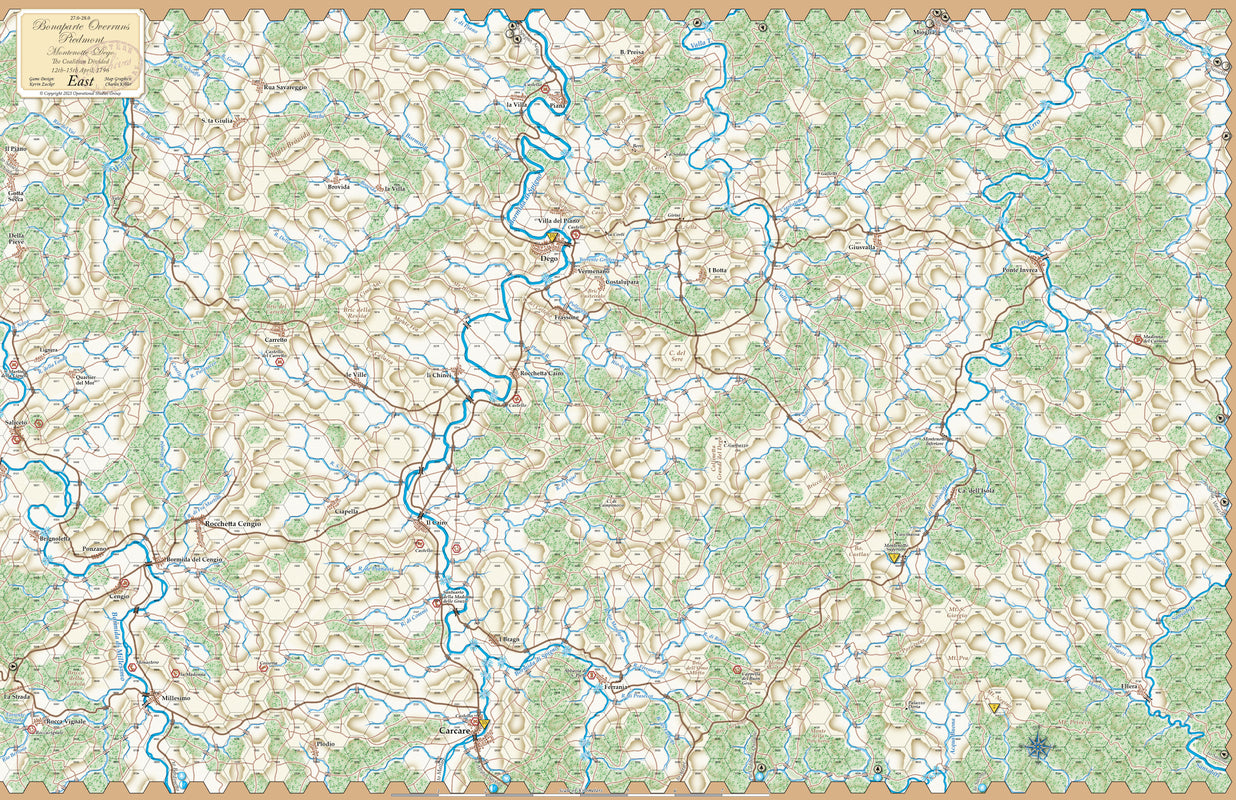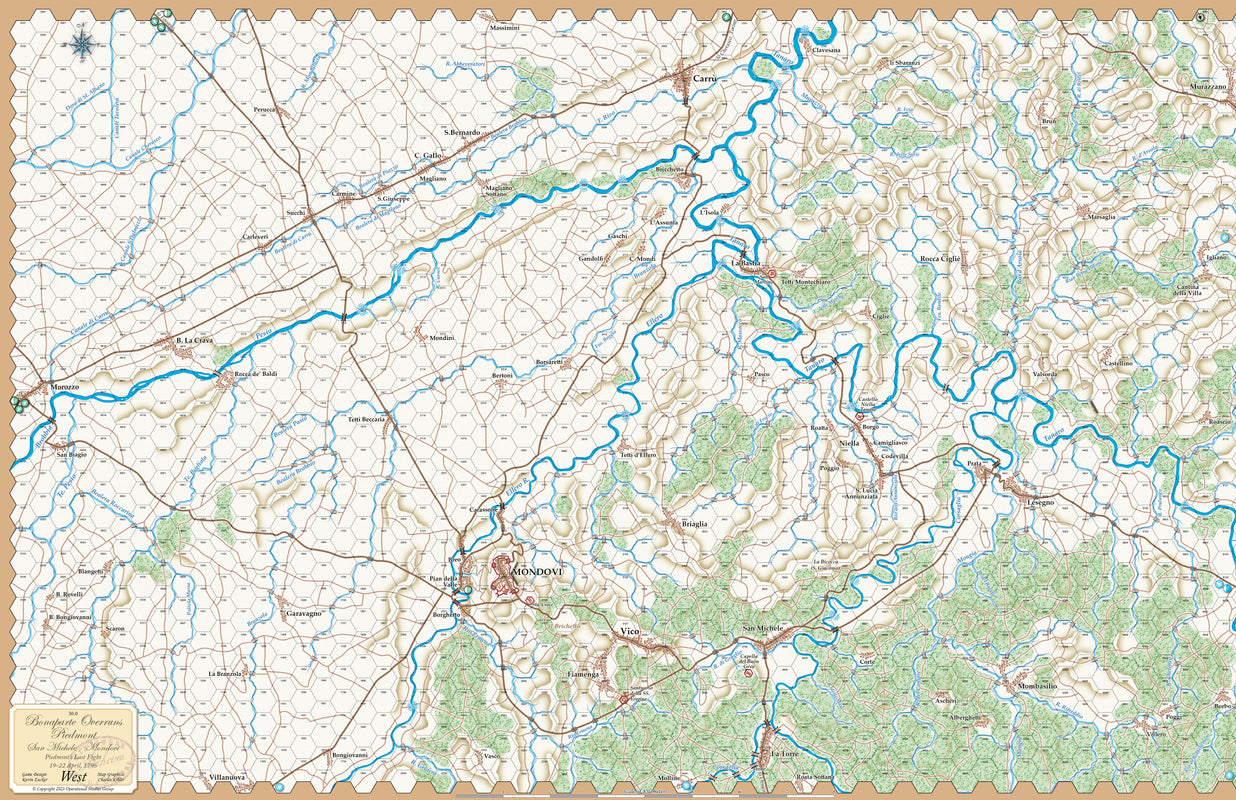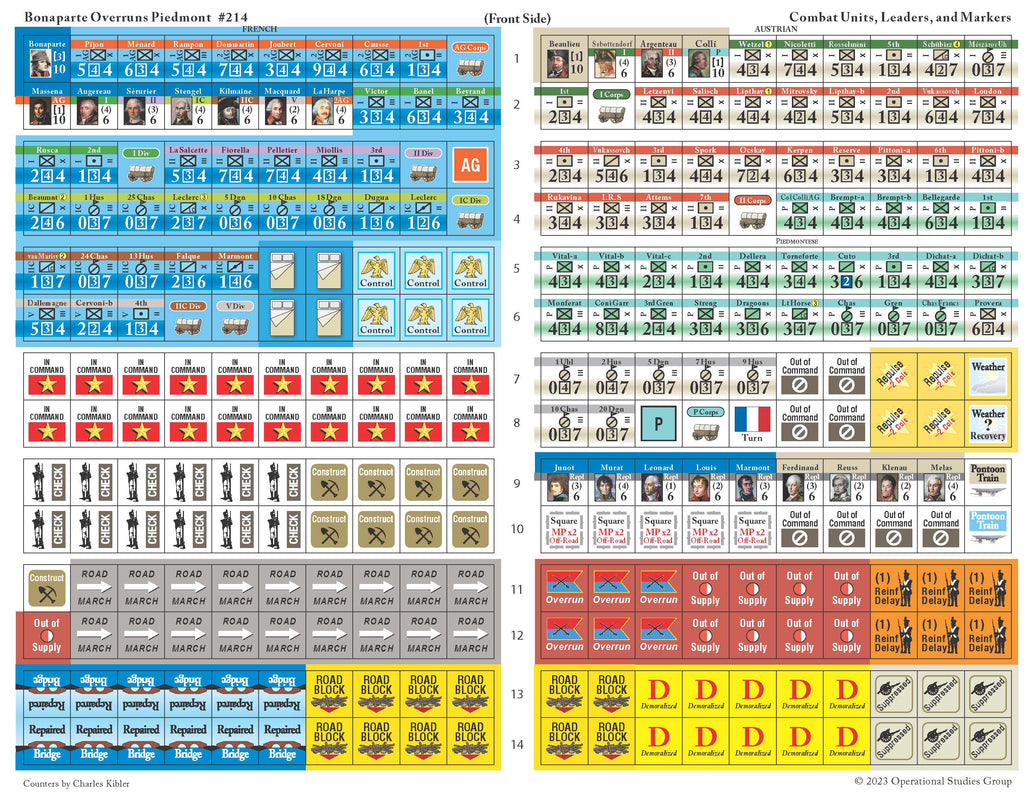
Bonaparte Overruns Piedmont
WINNER OF THE 2023 CHARLES S. ROBERTS AWARD FOR BEST NAPOLEONIC GAME
Click here for more about this year's awards.
War of the First Coalition, Part I
Bonaparte's First Offensive, April 1796
With his commission order fresh from Paris, Bonaparte established his HQ at Nice and took command of a front-line force of 35,168 men of the Army of Italy, ordering them across the mountains and heading for a fight at Montenotte. After Beaulieu's 26,697 men of the Army of Italy escaped from harm's way and sprinted for Acqui, the Piedmontese Army became Bonaparte's next target.
Unless otherwise indicated, all paintings on this page: Keith Rocco, "Napoleon's First Italian Campaign" (2013)
Artwork: www.keithrocco.com

Montenotte
Attack in the West, 12 April 1796
On 10 April, the left wing of the Austrian army under Beaulieu moved against Cervoni's advanced post at Voltri. Beaulieu was isolated from his right wing under Argenteau.
At dawn on 12 April, French cannon began firing from Monte Negino on the advancing Austrians. Argenteau deployed the Stein and Pellegrini battalions to hold the center and assigned two more battalions to defend the left flank on Monte Pra. Then he took the Alvinczi battalion to rescue the 3rd Terzi battalion on his right.
Laharpe fell on the Austrians stoutly defending Monte Pra, but Masséna’s assault made such rapid progress that Argenteau ordered a retreat, in which the 3rd Terzi battalion was nearly destroyed. The Alvinczi battalion provided the rear guard, losing its color and many soldiers. Argenteau’s men barely cleared Montenotte Inferiore before Masséna and Laharpe arrived. By 9:30 AM the battle was over. The Austrians, who went into action with 9,000 men, lost 2,500 killed, wounded, and captured, and 12 guns. Most of Argenteau’s casualties were prisoners; the French lost 880 out of 10,000 available troops.
Dego
The Coalition Forces are Divided, 14-15 April 1796
Augereau was sent to attack the Piedmontese position and meet up with Sérurier advancing from Ormea. Masséna and Laharpe were ordered up the Bormida valley to attack Dego’s garrison of 4,000 men strongly posted on the east bank of the Bormida River. Massena fixed the garrison with a frontal attack while extending his right along the high ground to the east. At the same time, La Harpe came down the west bank and crossed below Dego. The Austrians put up a good fight, but were eventually forced out having suffered 350 casualties and at least 1,500 prisoners. The victorious French then scattered to search for food.
At daybreak of 15 April, Vukassovich’s 3,500 fresh Austrians attacked Dego and the disorganized French were completely routed. At 4 PM the French counterattacked, thrown back three times. Menard worked his way around the Austrian left, and a fourth assault broke into the town.
On 16 April Augereau attacked the naturally strong position of the Pedaggera Pass. After stopping this assault, Colli’s flanks were still under threat by French columns maneuvering to bypass him. He exploited the short lull to fall back to the River Corsaglia—uncovering the fortress of Ceva.

San Michele
The Corsaglia Line, 19 April 1796
The Corsaglia was in full spate and impassable. The Piedmontese artillery opened up with a well-directed fire. Augereau's attack was called off. Sérurier’s two columns were also halted on the right bank, exposed to the guns. Sérurier contemplated aborting the operation when his men saw some enemy soldiers crossing the river on a footbridge. The French immediately crossed behind them, rushing into San Michele and overrunning a battery. Dichat’s grenadiers were holding on inside the village but elsewhere the men began to melt away. Surrounded on all sides, facing desperate house-to-house combat at odds of 1:6, Dichat's 600 had surrendered by 1:30 P.M.
The hungry French stopped to loot the village and in the confusion, Captain Schreiber's 73 Swiss Grenadiers boldly jumped into the fray. They seized a gun and turned it against its owners, then proceeded to reach Dichat’s grenadiers and rearm them with their muskets stacked nearby. Colli showed up and mounted a counterattack with the grenadiers and a battalion of the Savoy Regiment. The sight of the grenadiers' bayonets was too much for Sérurier’s division, which stampeded for the bridge. Apart from the small bridgehead on the western bank, Sérurier’s division was repulsed altogether. The French lost 600 or 700 dead and wounded, and 100 prisoners. The Sardinians lost 150 dead and 200 wounded.

Mondovi
Piedmont’s Last Fight, 21 April 1796
Bonaparte brought Masséna's division forward while to the northeast, Beaulieu still hesitated to mount an effort to help his ally. On the night of 20 April, Colli withdrew his army from the Corsaglia position, to fall back behind the Ellero River at Mondovì. The next morning, Sérurier's advance struck the Piedmontese rearguard on the heights of Buon Gesù and drove it back on the town of Vicoforte. Sérurier led a charge with Masséna's division following.
The timing of this attack prevented Colli from deploying properly. A few of his units panicked and fled, leaving gaps in the line. Fiorella and Guieu’s brigades, supported by Masséna, captured Vicoforte. The Piedmontese at La Bicocca held firm until Dichat was killed, then joined the disorderly retreat. Bonaparte lost 600 killed and wounded out of 17,500. The Piedmontese lost 1800 men, 4 generals, 11 standards, and 8 guns at Mondovi out of 13,000.
[Picture is View of the Battle of Mondovi,
by Giuseppe Pietro Bagetti]

Game Maps and Counters
Bonaparte Overruns Piedmont
Each game includes three high quality maps (shown below): one 17"x22" map and two 22"x34" maps.
Each game also includes one counter sheet.
Operational Studies Group (OSG) is a leader in the design and production of Napoleonic Wargames. Our maps are extensively researched, historically accurate, and printed on heavy cardstock in full color.
Game Components
Bonaparte Overruns Piedmont
Each game includes:
Game Box
2 Maps 34"x22"
1 Map 17"x22"
1 Counter Sheet (280 die-cut player pieces)
2 Booklets (System Rules and Study Folder)
16 Player Aid Cards
5 Resource Cards (Adding the Cards Folder, Combat Tables Folder, Orders Slip Sheet/Sequence of Play, Victory Worksheet, Cards Removed from Deck/Scenario Parameters)
NOT INCLUDED: Optional Card Decks
This game uses the two TLNB Universal Card Decks (French and Coalition). If you do not have them in Napoleon's Wheel or another OSG game, they can be ordered separately.
UNIVERSALITY: The same decks can be used for every game in the series. Click the link above for a description.
Visit our Game Components section for details.
Player Resources
CLICK PDF FILE TO DOWNLOAD
• Montenotte Setup Sheet v1.06
• Dego Setup Sheet v1.02
• Ceva Setup Sheet v1.02
• San Michele Setup Sheet v1.02
• Mondovi Setup Sheet v1.03
• Bonaparte Overruns Piedmont Setup Card v2.17
• Bonaparte Overruns Piedmont Update for All Study Versions 21AUG23
• Study Folder 1.62
• Bonaparte Overruns Piedmont 30.0 Turn Record Track 9AUG23
• Bonaparte Overruns Piedmont 29.0 Turn Record Track 9Aug23
• Bonaparte Overruns Piedmont French Setup 12AUG23
• A Weird What If
• Bonaparte Overruns Piedmont Update for Study 1.61 Only 26FEB23
• Bonaparte Overruns Piedmont 28.0 Turn Record Track 26FEB23
• Bonaparte Overruns Piedmont 31.0 Turn Record Track 26FEB23










